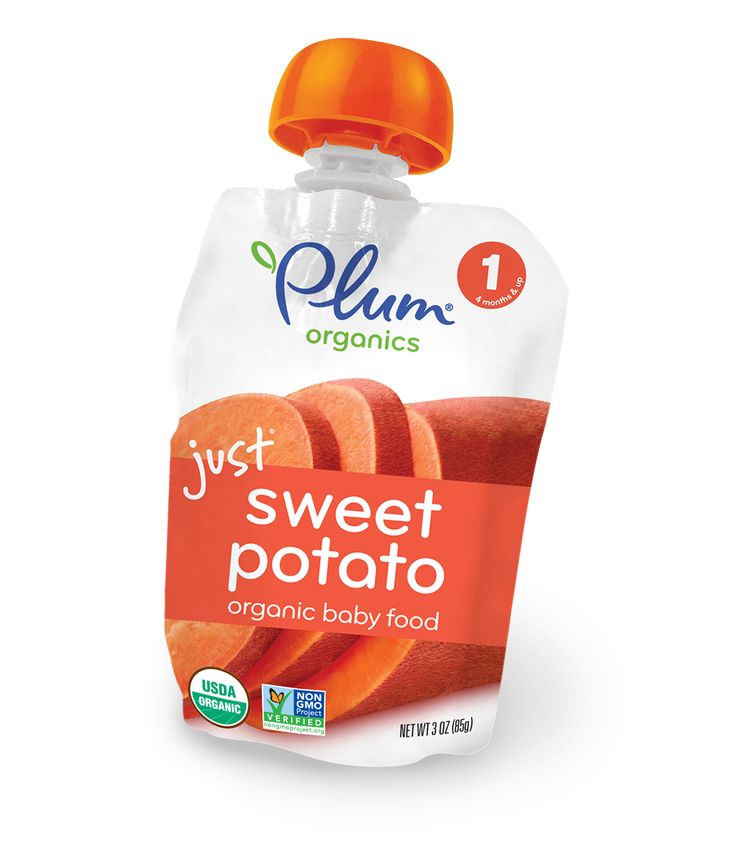Food for four months old baby
Top 10 Ideas For 4 Month Baby Food
Some fruits and boiled vegetables may be given to your baby to fulfill their needs.
Image : Shutterstock
Finding suitable food ideas for your four months old baby may be confusing as this is probably the first time they are being introduced to solid food.
As babies turn four months, they become more active and playful. In addition, they start to exhibit more interest in their surroundings. Their stomachs also grow bigger and are ready for more food. Moreover, they seem less interested in milk and are ready to explore new food varieties.
If you recognize these signs in your baby, it is an indication that they have reached the developmental milestone where you may introduce them to solid foods.
Read the post to find whether your baby is ready for solids and to discover some interesting food ideas for them.
Is Your Baby Ready For Solids?
Your baby must have lost the ‘tongue thrust reflex’ by the time he is four months of age. Thrust reflex prevents the infants from choking. It also causes them to push the food out of their mouths. The World Health Organization recommends that we start solids at six months but solids may be introduced at four months. If your baby seems unsatisfied after milk feeds, can hold their head up without any support, can sit without support, wakes up more frequently at night to feed, follows your food with their eyes when you eat, then probably it is the time to introduce him to solid foods. See if your baby is interested in the food or not. If your child stares and grabs your food at dinnertime, then he is ready for some variety. The baby should be able to sit well without any support. Your child needs a good neck control to eat solid foods. It will enable him to swallow his food efficiently. The 4 months baby food should consist of solids.
Top 10 Ideas:
Here are the top 10 ideas for 4 month baby food old as he begins his journey into solid foods.
1.
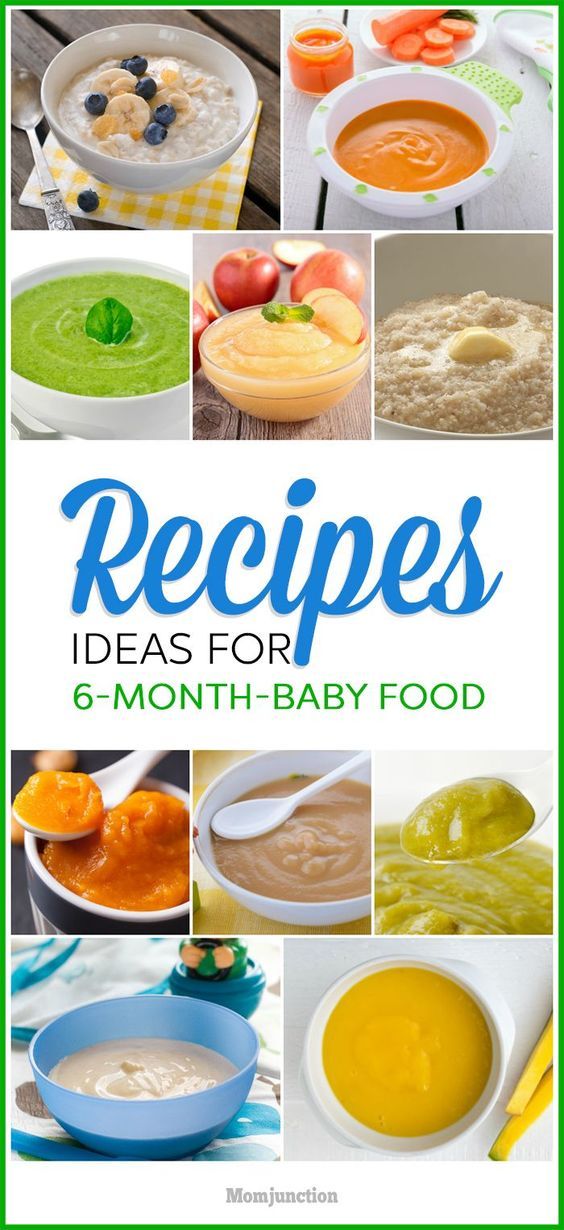 Baby Cereal:
Baby Cereal:Baby cereal is the most recommended first food for infants. Prepare the cereal with formula or breast milk. It will give the cereal a texture and taste that he is already familiar with. Cereal is also one of the least allergenic foods, making it suitable for babies of 4 months. Give gluten-free cereal, particularly if you have a family history of Celiac diseases or allergies. Wheat, barley and rye cereal may be unsuitable for babies as they contain gluten. Rice and oatmeal are the least allergenic varieties of cereal.
2. Avocado:
Image: Shutterstock
If you want to serve a complete and delicious meal for your baby, then you can serve him avocado. Slice an avocado and spoon out the flesh. Mash it with a fork or puree in a food processor. Add breast milk or formula milk to make it more ‘soupy’.
3. Banana:
Bananas are considered one of the nature’s most perfect foods. Babies love them for their natural sweetness. Also, banana is rich in fiber, so it will keep the things moving through your tot’s digestive system. Remove the skin of the banana and puree the flesh. You can also thin it with a little formula milk or breast milk. The food for 4 months baby is tasty with this all round nutritious fruit.
Remove the skin of the banana and puree the flesh. You can also thin it with a little formula milk or breast milk. The food for 4 months baby is tasty with this all round nutritious fruit.
4. Butternut Squash:
Image: Shutterstock
Butternut squash has a pleasing texture, making it ideal for a baby’s palate. Baked butternut squash will make a great food for your little one. All you need to do is pierce the butternut squash and bake for an hour at 375 degrees. Cut it lengthwise and then scoop out the fibers and seeds. Then spoon out the flesh and mash with a fork or masher.
5. Sweet Potato:
Sweet potato is a popular first food for babies. It is easier to digest and does not cause constipation in children. Cut the sweet potato and simmer in a little water until tender. Transfer to a food processor and puree, adding a little water or breast milk.
6. Carrots:
Image: Shutterstock
Carrot is another great choice for baby food. Cut the carrots into sticks and bake for over 20 to 30 minutes at 375 degrees Fahrenheit. The food for 4 month old baby is healthy with carrots.
Cut the carrots into sticks and bake for over 20 to 30 minutes at 375 degrees Fahrenheit. The food for 4 month old baby is healthy with carrots.
7. Apple:
With your doctor’s consent, you can serve cooked apples to your baby. Dice the apple and simmer or steam until tender. Cooking apple until it is just tender will ensure that all the nutrients are preserved. Transfer to a blender or food processor and blend until smooth. The 4 month old baby food is extremely nutritious with this addition.
8. Pear:
Image: Shutterstock
Pears are one of the safest foods to give as a first food. The allergic reactions to pear are rare. Also, they have a low acidity level, which makes them gentle on the tiny tummies. Puree steamed pear and add to the baby’s cereal.
9. Milk:
At this stage, breast milk will provide total nutrition to your baby. Don’t even think of replacing breast milk or formula until 12 months of age. It can cause serious health implications. Also, never give your child low-fat or skim milk products until he is 2 years old. The 4 months old baby food is extremely delicious with milk.
Also, never give your child low-fat or skim milk products until he is 2 years old. The 4 months old baby food is extremely delicious with milk.
10. Peas:
Image: Shutterstock
Fiber filled peas will make an ideal first veggie for babies. Steam the peas for 6 minutes and puree in a food processor, adding the cooking liquid. Strain using a sieve to discard the solids. Pea puree may thicken after it is refrigerated. So stir in a small amount of water, formula or breast milk while heating.
Tips:
- A baby’s tummy is the size of his fist. Do not expect your baby to finish a meal. He probably will eat just ½ of a tablespoon portion of what you serve to him.
- Serve a food to baby for four days at a stretch. It will help you learn the signs of intolerance and allergy. Follow this process until your baby has tried a variety of foods.
- Always serve cooked veggies to your baby so that he can chew it easily. Cooking breaks down the cell wall, making the food easier to digest by the baby.

- Place the spoon near your baby’s lips and let him taste and smell. Don’t be surprised if your tot rejects the first spoon. Wait for a few minutes and try again.
- Do not add any salt or pepper to the baby food.
- As your baby gets used to solid food, make the puree less runny. You can mash the food instead of pureeing it.
1. What if a baby refuses their first solid food?
A baby might refuse solid food if they are full, unwell, or irritable. Hence, try feeding them when they are hungry. Check the consistency of the solid food and make it baby-compatible. Foods that are too hot or too cold might also be refused. Try a variety of foods initially to see the taste they prefer the most. If your baby still refuses to eat solid foods, consult a pediatrician.
2. Can I give my four-month-old orange juice?
Juices may seem easy to introduce babies to the taste of fruits. However, the American Academy of Pediatrics advises not to give babies juices until one year unless recommended by a pediatrician (1).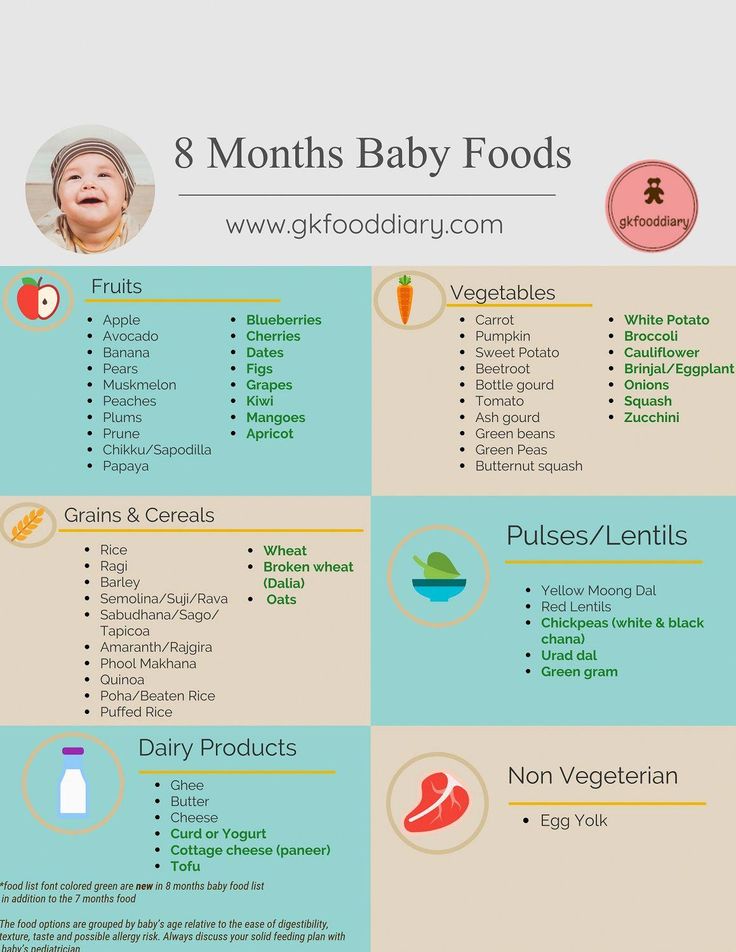
3. How do I keep baby foods safe?
Always feed your baby fresh, home-cooked food. Wash the ingredients properly in clean tap water. If you are preparing baby food in bulk, freeze the food immediately in a tightly sealed container. Label the container with the date of preparation and time. Only take out the required amount of food from the container when feeding a baby (2). Always check the quality of the food before feeding it to a baby.
If you are looking for food ideas for your 4-month-old baby, begin by offering easily digestible foods such as bananas, sweet potatoes, and cereals. At four months, your tiny tot may be interested in eating foods other than milk. Though most babies are fed various solid foods after six months, you may introduce mashed forms of foods after they cross the four-month mark. Nevertheless, do not rush into introducing foods to your baby. Also, remember that all babies do not react to new foods alike. Hence, if you notice that your baby is not interested in certain foods, give them some time or try feeding other varieties.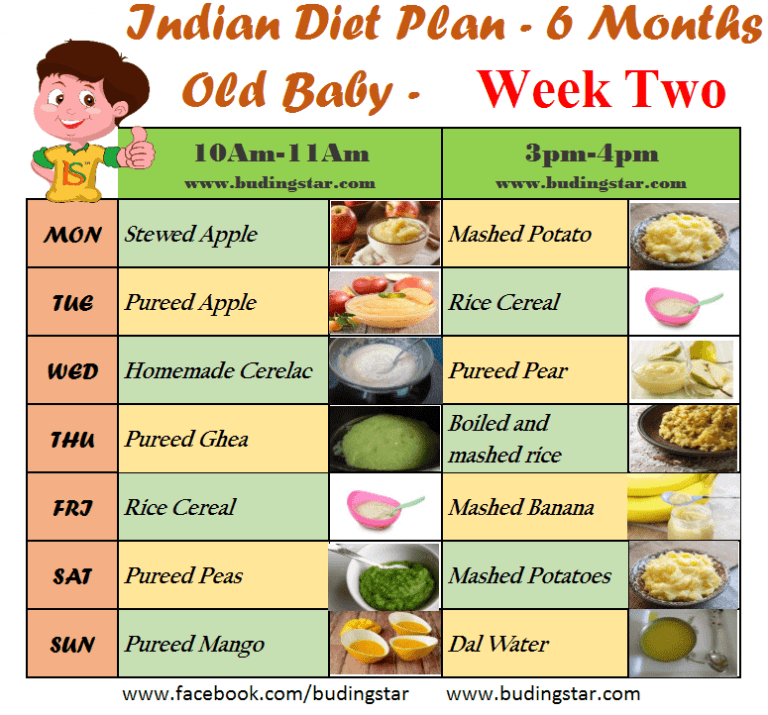
Key Pointers
- 4-month-old babies can consume the puree of avocado, banana, and carrots.
- To identify food intolerance issues while introducing solids, serve one food for three to four days instead of feeding mixed foods.
- Avoid adding spices or salt to baby food.
References:
MomJunction's articles are written after analyzing the research works of expert authors and institutions. Our references consist of resources established by authorities in their respective fields. You can learn more about the authenticity of the information we present in our editorial policy.
- Weighing in on fruit juice: AAP now says no juice before 1.
https://publications.aap.org/aapnews/news/14804 - How to make homemade baby food?
https://www.eatright.org/food/planning-and-prep/snack-and-meal-ideas/how-to-make-homemade-baby-food#
The following two tabs change content below.
- Reviewer
- Author
Jessica Albert is a passionate writer who seeks to connect with her readers through wit and charm. Her work aims to invoke curiosity and keep the readers engaged through and through. She has prior experience working with magazines and e-commerce establishments as a content marketer and editor. Being a mother herself, she puts all her knowledge into creating content about... more
Moloko Mehlape is a registered dietitian in private practice with special interest in nutrition education, sports nutrition, weight and chronic disease management. She is a philanthropist passionate about making a positive impact in public health through nutrition. Dt. Mehlape has completed extensive formal education and training, and holds qualifications BSc Dietetics (Hons) - Medunsa, MSc Dietetics from the University of... more
Is It Safe To Eat Lotus Seeds (Makhana)..
Is It Safe To Eat Lotus Seeds (Makhana)..
Dry Fruits During Pregnancy: Benefits,.
 .
.Dry Fruits During Pregnancy: Benefits,..
Spinach For Babies: Right Age, Benefits..
Spinach For Babies: Right Age, Benefits..
Cinnamon For Babies: Safety, Benefits..
Cinnamon For Babies: Safety, Benefits..
Is It Safe To Consume Cinnamon During..
Is It Safe To Consume Cinnamon During..
Top 10 Food Ideas For Your 16 Months..
Top 10 Food Ideas For Your 16 Months..
4 Possible Health Benefits Of..
4 Possible Health Benefits Of..
ORS for Babies: Dosage, Benefits And..
ORS for Babies: Dosage, Benefits And..
13 Excellent Benefits Of Avocados..
13 Excellent Benefits Of Avocados..
Foods, Tips, and Meal Plan for Feeding Your 9-Month-Old
By the time your baby is 9 months old, they have likely been eating solid foods in addition to either breast milk or formula for a few months.
It can be overwhelming deciding what foods to feed your little one, especially when you’re most likely already busy babyproofing and soaking up all the new and exciting milestones.
This article provides an overview of some of the best foods for your 9-month-old, as well as which foods are best avoided so that you can help your baby get all the nutrients they need.
Even though your 9-month-old is eating food, their main source of nutrition should continue to come from either breast milk or formula. Any additional foods can be considered complementary until your baby turns 1 (1, 2).
Some parents choose to begin with puréed foods when first starting solids, while others may opt for a baby-led weaning approach, which involves offering foods in their solid form with an emphasis on allowing babies to feed themselves (3).
If your baby eats purées, the American Academy of Pediatrics (AAP) recommends beginning to offer foods with varying textures and some more solid foods that help a baby learn how to chew around 8 months of age (2).
Some great foods to offer your 9-month-old baby include:
- Fruits: bananas, soft pears, peaches, watermelon, cantaloupe, strawberries
- Vegetables: soft-cooked broccoli, carrots, green beans, sweet potatoes
- Protein: eggs, soft-cooked or ground meat, tofu, smashed beans, low mercury fish
- Healthy fats: avocado, fish, olive oil, nut butters
- Iron-containing foods: eggs, meats, fish, iron-fortified cereals, whole grain bread or pasta
Key nutrients for baby
Offering a variety of foods will provide your baby with a variety of important nutrients, some of which are especially important for healthy growth and development.
Vitamin D plays an important role in bone health and may help build strong immune systems in babies, though more research is needed on the latter.
Infant formulas are typically fortified with vitamin D, but it’s often recommended that breastfed babies take a supplement of 400 IU of vitamin D per day for their first year of life (4, 5).
Because babies experience such rapid growth in the first year, they’re at a high risk of an iron deficiency, which can lead to serious health outcomes.
Iron supplementation may be needed after the first 6 months, but it may not be necessary if your baby is getting enough iron-rich food sources regularly or drinking formula, which is typically fortified with iron (5, 6).
Healthy fats, particularly omega-3 fatty acids, are also important for babies and young children. They help promote the development and function of brain, eye, and immune health (7, 8, 9).
SummaryOffering your baby a variety of foods will provide them with a variety of important nutrients, but keep in mind, their main source of nutrition should still be breast milk or formula at this age.
While most foods are OK for babies as long as they are prepared and cut appropriately, some foods should be avoided in the first year. Some foods may cause food poisoning in little ones, and others are considered choking hazards.
Here are some important foods to avoid feeding your 9-month-old (10):
- honey
- raw or undercooked meat, fish, or eggs
- fish containing high amounts of mercury, such as shark, swordfish, and marlin
- added sugars
- salt and high sodium foods
- unpasteurized foods
- potential choking hazards like whole grapes, whole nuts, raw fruits and veggies
You may have heard that babies under 1 year shouldn’t drink cow’s milk. That’s because they should still be drinking formula or breast milk to meet their nutritional needs.
They can have milk mixed into foods, such as oatmeal or smoothies, but you could also use breastmilk or formula.
Babies shouldn’t get added sugar, which can replace more nutritious options. Also, too much sodium may be harmful to their developing kidneys, so it’s best to limit their salt intake (10).
SummaryIt’s important to stay away from certain foods in the first year of life because they can cause food poisoning or choking or may not be the best choices for their developing bodies.

A 9-month-old needs 750–900 calories per day and about 400–500 should continue to come from breast milk or formula (2).
You don’t need to track your baby’s calorie intake, but you may wonder how much to offer at each meal and snack.
Babies will eat when they’re hungry and stop when they are full, so you can let them decide how much they would like to eat.
Your baby will likely show cues of feeling full, such as turning his or her head away from you or pushing food away, and also show signs that they’re hungry, such as opening their mouth for food or getting excited (11).
SummaryA 9-month-old baby needs about 750–900 calories per day. Be sure to keep up with regular formula or breast milk feedings to help them meet their needs, and let your baby decide when they’re full at meals.
It’s normal for your little one’s appetite to vary day to day. Remember, breast milk or formula should continue to be the main source of nutrition for the first year of life, and babies should be getting about 24 ounces (720 mL) of either daily (2, 12).
You can and should also offer water with meals at this age to encourage proper hydration and help wash down solid foods. At this age, it’s recommended babies get about 4–8 ounces (0.5–1 cup) of water per day (13).
As for other beverages, the AAP recommends sticking to just water and breast milk or formula at this age and avoiding sugar-sweetened beverages and other drinks until 2 years of age. Cow’s milk or soy milk can be introduced after 12 months (13).
Here’s a sample menu for a 9-month-old, including 3 meals, snacks, and breast milk or formula:
Breast milk or formula
6 ounces (177.4 mL)
Breakfast
- 2–4 ounces (59.1–118.3 mL) of prepared iron-fortified cereal
- a banana or other fruit (you can try cutting it up or mashing and mixing it into the cereal, too)
- about 1 teaspoon of nut butter stirred into the cereal
Snack (optional)
One of the following options:
- soft (or cooked) fruit
- plain, whole milk yogurt
- teething biscuits
Breast milk or formula
6 ounces (177. 4 mL)
4 mL)
Lunch
- scrambled egg
- soft-cooked broccoli
- whole wheat toast with mashed avocado (try cutting it into strips for easy self-feeding)
Snack (optional)
One of the following options:
- cubed cheese
- whole milk cottage cheese
- soft (or cooked) fruit
Breast milk or formula
6 ounces (177.4 mL)
Dinner
- soft-cooked shredded chicken (the slow cooker is great for this)
- smashed peas
- roasted sweet potato wedges
- soft (or cooked) fruit
Breast milk or formula
6 ounces (177.4 mL)
SummaryAbove is a sample menu for a 9-month-old baby. Remember, babies will let you know when they are full, and they may not eat everything offered. It’s important to continue to offer at least 24 ounces (720 mL) of breast milk or formula daily.
Feeding your little one can feel daunting, but there are ways to keep it simple so you don’t have to spend too much time cooking and prepping.
Here are some quick meal and snack ideas for your 9-month-old:
Quick and easy breakfast ideas
- scrambled eggs, or a veggie omelet with soft fruit, and whole wheat toast topped with smashed avocado
- French toast made with 1 egg and a sprinkle of cinnamon, topped with plain whole milk yogurt and no-sugar-added applesauce
- plain, whole milk yogurt or whole milk cottage cheese mixed with soft fruit and Cheerios
- iron-fortified cereals mixed with nut butter and smashed fruit
Quick and easy lunch or dinner ideas
- baby meatballs with mashed potatoes and soft-cooked green beans
- Combine 1 pound (0.45 kg) of ground meat with 1 egg and 1/2 cup oat flour (plus any seasoning you’d like, other than salt).
- Roll the mixture into meatballs and bake or cook them with a little chicken broth in an instant pot or slow cooker.
- shredded chicken with smashed peas and corn
- whole wheat penne pasta with low sodium marinara sauce
- poached fish with sweet potato wedges and soft-cooked broccoli and carrots
- diced tofu with soft-cooked green beans and smashed chickpeas
Quick and easy snack ideas
- soft-cooked vegetable finger food, such as asparagus, cauliflower, broccoli, carrots, or potatoes
- toast or crackers with smashed avocado
- soft or cooked fruits like banana, ripe peaches, strawberries, or cooked pears
- cubed cheese
- plain whole milk yogurt
- whole milk cottage cheese
- hard-boiled eggs
SummaryFeeding your 9-month-old can be overwhelming and time-consuming.
It’s a good idea to have some go-to ideas in your back pocket for quick and easy meals.
Meal prep
Meal prepping is a great way to save time and set yourself up for an easier week. If you can, try planning some meals ahead of time and doing some cooking in advance so that you can reheat things during the week rather than cooking daily.
By the time your little one is 9 months old, they can eat a lot of what you’re eating. When you prepare a meal for yourself or the rest of the family, see what you can do to make it baby-friendly. Here are some tips:
- Leave the salt out until you portion out your little one’s helping first.
- Cut foods into safe sizes for your baby to consume.
- If you’re using a spicy or high sodium condiment, set aside some food for your baby before adding it in.
- Check the texture of the meal yourself to make sure it’s soft enough for your baby. Pinching a food between your fingers is a great way to see whether they can squish it with their gums.

To reduce their choking risk, cut food small enough for them to grab and bite, but not so small that they can swallow it whole. Some raw fruits and vegetables, like apples and carrots, are also choking hazards because they’re too hard to bite into.
Food safety
It’s important to prepare your little one’s food using safe cooking practices to reduce the risk of foodborne illness.
Wash your hands and switch cutting boards when handling raw meat to avoid cross contamination. Cook meats, fish, and eggs to safe temperatures — 145–165°F (62.8–73.9°C) — depending on the food (14).
Be sure to refrigerate food soon after finishing it to preserve it. It’s also a good practice to date leftovers so you know when to throw them away. Most food lasts a few days in the refrigerator or 1–2 months in the freezer (15).
Allergens
By the time your child reaches this age, you may have already begun to introduce some common allergens, such as peanut butter, eggs, and fish. If you haven’t yet, now is a great time, as introducing them earlier on may help prevent an allergy (16, 17, 18).
If you haven’t yet, now is a great time, as introducing them earlier on may help prevent an allergy (16, 17, 18).
It’s a good idea to introduce allergens one at a time and wait a few days in between so that you can monitor your baby for any possible reaction (19).
Signs of an allergic reaction include (20):
- wheezing or coughing
- swelling in the lips or throat
- a runny nose
- itchy skin or a rash
- diarrhea, vomiting, or other signs of stomach upset
If you notice any signs of a mild allergic reaction, such as a rash or upset stomach, call your pediatrician. Call 911 if the symptoms are more severe, such as if you suspect anaphylaxis, which usually involves wheezing, hives, drooling, and drowsiness (21).
Packaged foods
Offering packed foods to your baby can be a convenient way to feed them when you’re short on time. We recommend offering a variety of whole foods whenever possible, but having some packaged items in the pantry can come in handy.
When shopping for packaged baby-friendly foods, look for foods that are low in sodium, added sugars, additives, and preservatives. Additionally, be sure they don’t contain any of the foods that should be avoided in the first year, such as honey.
Lastly, remember that mealtimes should be a fun, low pressure experience. Try not to force your baby to eat more if they are showing signs of feeling full. If they refuse a food, you can try offering it again another time.
Repeated exposure to new foods and maintaining a low stress environment has been shown to promote food acceptance among little ones (22).
SummaryProperly handling, preparing, and storing foods for your baby will help prevent choking and possible foodborne illnesses. Do your best to keep mealtimes fun and relaxed, and let your baby take the lead on how much to eat.
With so many exciting changes and challenges that come with parenting, thinking about and preparing healthy meals and snacks for your 9-month-old baby can feel overwhelming.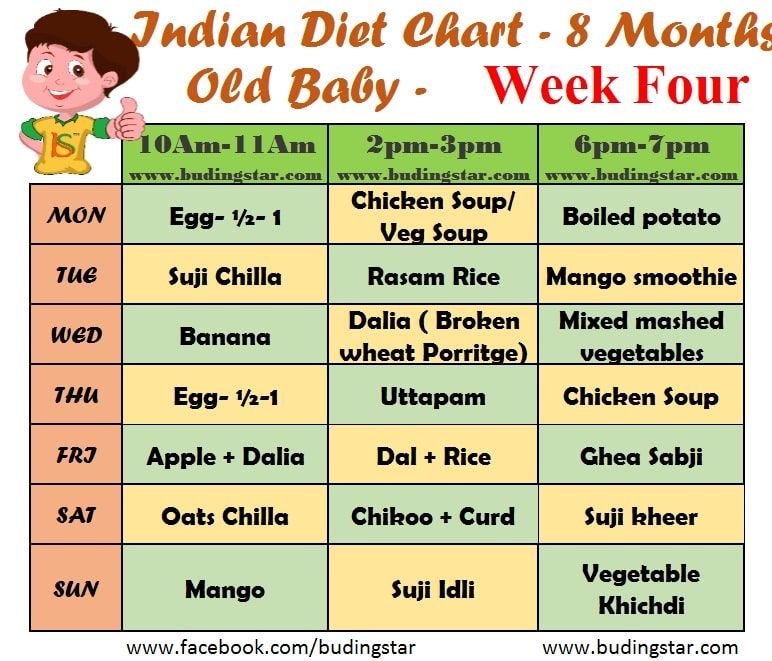
By planning ahead and having some go-to meal ideas, you’ll be able to throw together a healthy, balanced plate for your little one in less time.
Preparing some food ahead of time and making your own meal baby-friendly will help save time and the stress of putting together more than one meal.
While 9-month-olds can eat most of the foods you eat, some foods should be avoided, including honey, salt, added sugars, and undercooked or unpasteurized foods.
Properly handling, cooking, and storing your baby’s food will significantly decrease the risk of them experiencing a foodborne illness. Be sure to cut your little one’s food into safe shapes and offer appropriate textures to reduce their choking risk.
Just one thing
Try this today: Combine 1 pound (0.45 kg) of ground meat (chicken, turkey, beef, or pork), 1/2 cup (45 grams) of oat flour, 1 egg, and 2 teaspoons of dried oregano.
Roll the mixture into meatballs and place them on a greased baking sheet in the oven at 400°F (204°C) for 20–25 minutes, or until they’re fully cooked.
Freeze them and defrost 1 or 2 at a time when you need a quick protein source for your little one.
Diet for a child aged 4
Your baby is already 4 months old. He has noticeably grown up, become more active, is interested in objects that fall into his field of vision, carefully examines and reaches for them. The emotional reactions of the child have become much richer: he joyfully smiles at all the people whom he often sees more and more often, makes various sounds.
Are you still breastfeeding or have you switched to formula or formula feeding? The child is actively growing, and only with breast milk or infant formula, he can no longer always get all the necessary nutrients. And that means it's time to think about complementary foods.
Optimal time to start its introduction is between 4 and 6 months, regardless of whether the baby is receiving breast milk or formula. This is the time when children respond best to new foods. Up to 4 months, the child is not yet ready to perceive and digest any other food. And with the late introduction of complementary foods - after 6 months, children already have significant deficiencies of individual nutrients and, first of all, micronutrients (minerals, vitamins, long-chain polyunsaturated fatty acids, etc.). In addition, toddlers at this age often refuse new foods, they have delayed development of chewing skills for thick foods, and inadequate eating habits are formed. It is important to know that, no matter how strange it may seem at first glance, with a delayed appointment of complementary foods, allergic reactions more often occur on them.
And with the late introduction of complementary foods - after 6 months, children already have significant deficiencies of individual nutrients and, first of all, micronutrients (minerals, vitamins, long-chain polyunsaturated fatty acids, etc.). In addition, toddlers at this age often refuse new foods, they have delayed development of chewing skills for thick foods, and inadequate eating habits are formed. It is important to know that, no matter how strange it may seem at first glance, with a delayed appointment of complementary foods, allergic reactions more often occur on them.
When is it advisable to introduce complementary foods as early as 4 months, and when can you wait until 5.5 or even 6 months? To resolve this issue, be sure to consult a pediatrician.
The optimal time to start introducing complementary foods to a healthy baby is between 5 and 5.5 months of age.
The World Health Organization recommends that breastfed babies should be introduced to complementary foods from 6 months of age.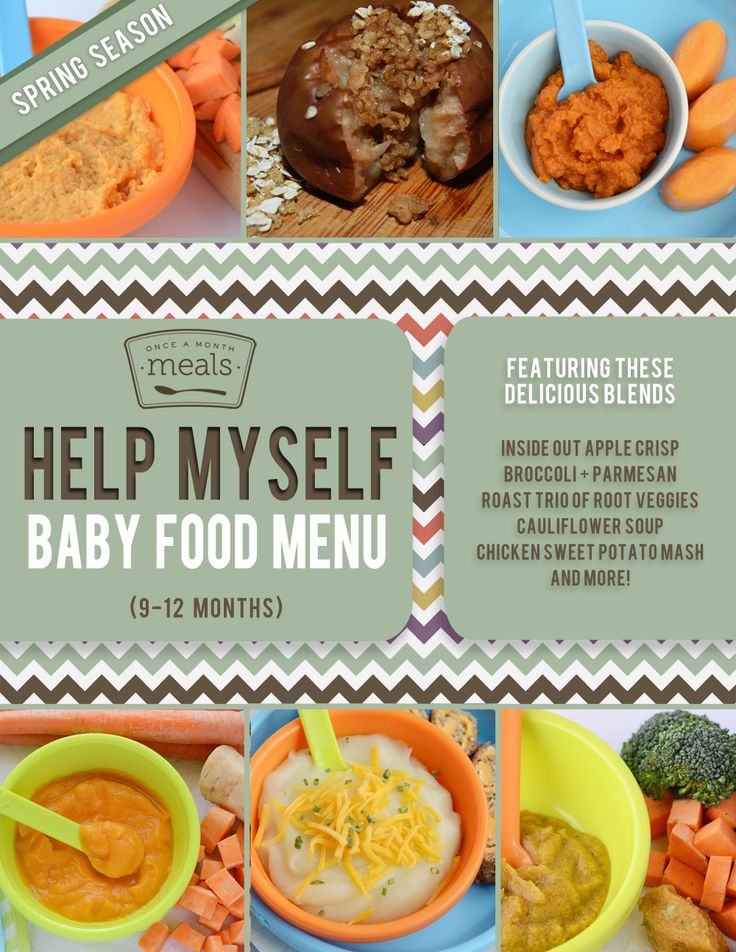 From the point of view of domestic pediatricians, which is based on the big
From the point of view of domestic pediatricians, which is based on the big
practical experience and scientific research, this is possible only in cases where the child was born at term, without malnutrition (because in these cases the mineral reserves are very small), he is healthy, grows and develops well. In addition, the mother should also be healthy, eat well and use either specialized enriched foods for pregnant and lactating women, or vitamin and mineral complexes in courses. Such restrictions are associated with the depletion of iron stores even in a completely healthy child by 5-5.5 months of age and a significant increase in the risk of anemia in the absence of complementary foods rich or fortified with iron. There are other deficits as well.
The first food product can be vegetable puree or porridge, it is better to give fruit puree to the baby later - after tasty sweet fruits, children usually eat vegetable puree and cereals worse, often refuse them altogether.
Where is the best place to start? In cases where the child has a tendency to constipation or he puts on weight too quickly, preference should be given to vegetables. With a high probability of developing anemia, unstable stools and small weight gain - from baby cereals enriched with micronutrients. And if you started the introduction of complementary foods with cereals, then the second product will be vegetables and vice versa.
If the first complementary foods are introduced at 6 months, it must be baby porridge enriched with iron and other minerals and vitamins, the intake of which with breast milk is no longer enough.
Another important complementary food product is mashed meat. It contains iron, which is easily absorbed. And adding meat to vegetables improves the absorption of iron from them. It is advisable to introduce meat puree to a child at the age of 6 months. Only the daily use of children's enriched porridge and meat puree can satisfy the needs of babies in iron, zinc and other micronutrients.
But it is better to introduce juices later, when the child already receives the main complementary foods - vegetables, cereals, meat and fruits. After all, complementary foods are needed so that the baby receives all the substances necessary for growth and development, and there are very few in their juices, including vitamins and minerals.
Juices should not be given between feedings, but after the child has eaten porridge or vegetables with meat puree, as well as for an afternoon snack. The habit of drinking juice between meals leads to frequent snacking in the future, a love of sweets is instilled, children have more tooth decay and an increased risk of obesity.
With the start of the introduction of complementary foods, the child is gradually transferred to the 5-time feeding regimen.
Complementary feeding rules:
- preference should be given to baby products of industrial production, they are made from environmentally friendly raw materials, have a guaranteed composition and degree of grinding
- Complementary foods should be offered to the baby by spoon at the start of feeding, before breastfeeding (formula feeding)
- the volume of the product increases gradually, starting with ½ - 1 spoon, and in 7 - 10 days we bring it to the age norm, subsequent products within the same group (cereals from other cereals or new vegetables) can be introduced faster, in 5 - 7 days
- start introduction with monocomponent products
- it is undesirable to give a new product in the afternoon, it is important to follow how the child reacts to it
- do not introduce new products in the event of acute illnesses, and before and immediately after prophylactic vaccination (should be abstained for several days)
When introducing a new type of complementary food, first try one product, gradually increasing its amount, and then gradually "dilute" this product with a new one. For example, vegetable complementary foods can be started with a teaspoon of zucchini puree. During the week, give the baby only this product, gradually increasing its volume. After a week, add a teaspoon of mashed broccoli or cauliflower to the zucchini puree and continue to increase the total volume every day. Vegetable puree from three types of vegetables will be optimal. The portion should correspond to the age norm. Over time, you can replace the introduced vegetables with others faster.
For example, vegetable complementary foods can be started with a teaspoon of zucchini puree. During the week, give the baby only this product, gradually increasing its volume. After a week, add a teaspoon of mashed broccoli or cauliflower to the zucchini puree and continue to increase the total volume every day. Vegetable puree from three types of vegetables will be optimal. The portion should correspond to the age norm. Over time, you can replace the introduced vegetables with others faster.
After the introduction of one vegetable (bringing its volume to the required amount), you can proceed to the intake of porridge, and diversify the vegetable diet later.
If the child did not like the dish, for example, broccoli, do not give up on your plan and continue to offer this vegetable in a small amount - 1-2 spoons daily, you can not even once, but 2-3 times before meals, and after 7 - 10, and sometimes 15 days, the baby will get used to the new taste. This diversifies the diet, will help to form the right taste habits in the baby.
Spoon-feed with patience and care. Forced feeding is unacceptable!
In the diet of healthy children, porridge is usually introduced after vegetables (with the exception of healthy breastfed children, when complementary foods are introduced from 6 months). It is better to start with dairy-free gluten-free cereals - buckwheat, corn, rice. At the same time, it is important to use porridge for baby food of industrial production, which contains a complex of vitamins and minerals. In addition, it is already ready for use, you just need to dilute it with breast milk or the mixture that the baby receives.
Children suffering from food allergies are introduced complementary foods at 5-5.5 months. The rules for the introduction of products are the same as for healthy children, in all cases it is introduced slowly and begins with hypoallergenic products. Be sure to take into account individual tolerance. The difference is only in the correction of the diet, taking into account the identified allergens.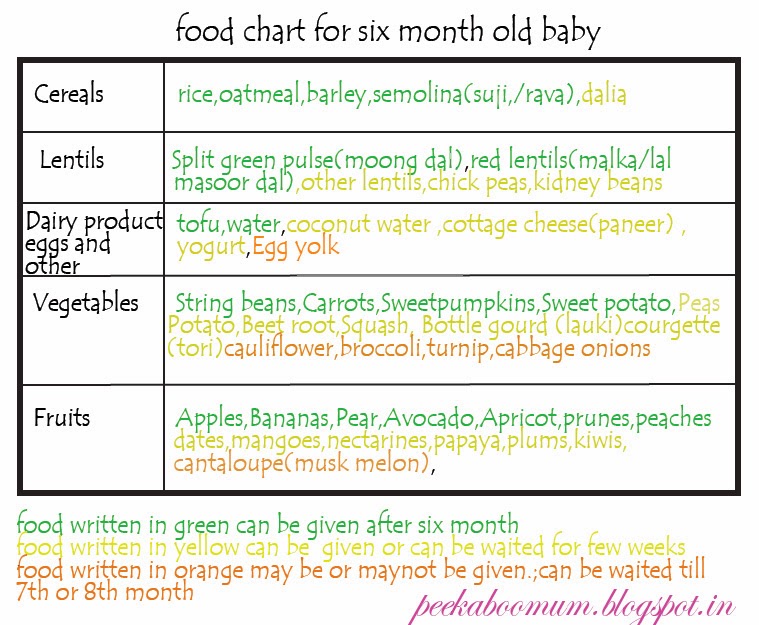 From meat products, preference should first be given to mashed turkey and rabbit.
From meat products, preference should first be given to mashed turkey and rabbit.
Diets for different age periods
explain how to make a diet, it is better on several examples that will help to navigate the menu for your child.
From 5 months, the volume of one feeding is on average 200 ml.
Option 1.
I feeding
6 hours
Breast milk or VHI*
200 ml
II feeding
10 hours
Dairy-free porridge**
Supplementation with breast milk or VHI*
150 g
50 ml
III feeding
14 hours
Vegetable puree
Meat puree Vegetable oil
Supplemental breast milk or VHI*
150 g
5 - 30 g
1 tsp
30 ml
IV feeding
18 hours
Fruit puree
Breast milk or VHI*
60 g
140 ml
V feeding
22 hours
Breast milk or VHI*
200 ml
* - Children's dairy mixture (VHI)
** - diluted with breast milk or VHI
Option 2.
9000 9000 9000 9000 9000 9000 9000 9000 9000 9000 9000 9000 9000 9000 9000 9000 9000 9000 9000 9000 9000 9000 9000 9000 9000 9000
baby 6 months, if complementary foods were introduced from 4 - 5 months:
| I feeding | Breast milk or VHI* | 200 ml |
| II feeding | Dairy-free porridge** | 150 g |
| III feeding | Vegetable puree | 150 g |
| IV feeding | Fruit puree | 40 g |
| V feeding | Breast milk or VHI* | 200 ml |
* - Children's dairy mixture
** - diluted with breast milk or DMS
Option 3.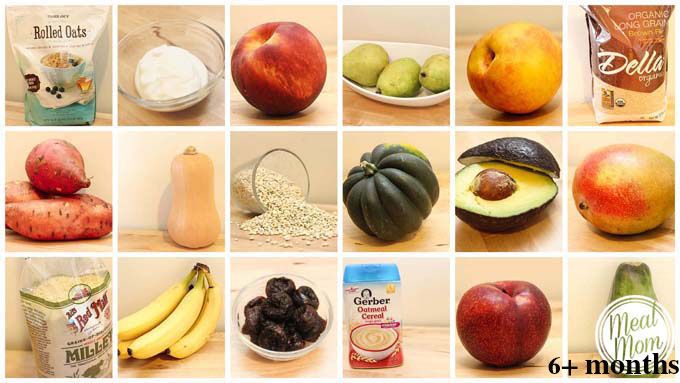
An approximate daily diet for a baby at 6.5 months on breastfeeding, if complementary foods began to be administered from 6 months:
| I feeding | Breast milk | |
| II feeding | Dairy-free porridge** | 100 g |
| III feeding | Vegetable puree | 100 g |
| IV feeding | Breast milk |
|
| V feeding | Breast milk |
|
** - diluted with breast milk
Up to 7 months, increase the volume of porridge and vegetable puree to 150 g and introduce fruit puree.
Complementary foods at 4 months | Useful tips from the Tyoma brand
It is well known that the ideal time to introduce complementary foods is between 4 and 6 months of age. The presence of a child's teeth or the ability to sit are not signs of a child's readiness for complementary foods. It is important that the baby does not have a reflex of pushing the spoon with his tongue, and he can swallow food thicker than breast milk or formula well.
The pediatrician will help determine the exact start date for complementary foods, and in most cases this is the golden mean of 5-5.5 months. But there are situations when complementary foods need to be started from 4 months, including even a child who is exclusively breastfed.
In what cases are complementary foods introduced from 4 months?
- The child is not gaining weight well or is lagging behind in physical development.
- The child has functional digestive disorders (regurgitation, constipation).

- The mother has little breast milk or it is poorly absorbed.
- The child has a reduced appetite or is not digesting formula well.
- The child has signs of iron deficiency (anemia).
- The child has a pronounced food interest: he watches with interest the food of adults, reaches for food.
- The child stopped eating formula and began to demand food more often.
How to start complementary foods at 4 months?
The first product of complementary foods, regardless of the age and type of feeding of the baby (breast or artificial), should be energy-intensive foods: either porridge or vegetable puree. Porridge can be chosen first if the child has loose or unstable stools, and also if the child is underweight. After 4-5 days from the beginning of the introduction of porridge, butter can be gradually added to it (up to 5 g per serving of porridge in 150 g)
Mashed vegetables can be the first meal of the day if a child is prone to constipation, when it is better to choose zucchini, which can have a mild laxative effect on the child's stool. Starting from the 4-5th day of the introduction of vegetable puree, vegetable oil can be gradually added to it (up to 5 g per serving of vegetables in 150 g).
Starting from the 4-5th day of the introduction of vegetable puree, vegetable oil can be gradually added to it (up to 5 g per serving of vegetables in 150 g).
What foods can be introduced into the diet of a child at 4 months?
Kashi
Of the first cereals, it is better to give preference to buckwheat or rice. They must be dairy-free and can be diluted with water or breast milk, or the mixture that the baby eats. Later, you can introduce corn and oatmeal.
Vegetables
The first vegetable puree can be zucchini, broccoli, or cauliflower.
Fruit
The third type of complementary food can be fruit puree from apples or pears. Later, you can introduce mashed banana or apricot. At first, fruit puree can not be given to the child separately, but it is better to mix it with cereal or vegetables so that the child does not begin to prefer the sweet taste of fruits. When the amount of fruit puree reaches 50 g or more, it can also be given separately, for example, after the child has eaten porridge or for an afternoon snack.
Juices
Juices should not be the first feeding, in addition, they can not be introduced into the baby's first year of life at all, given their sweet taste and low nutritional value.
Can you make your own first meal?
You can prepare the first complementary foods yourself, but it is safer to use hypoallergenic monocomponent cereals or commercially produced purees prepared to high quality standards for baby food. In addition, it is important to consider that industrially produced baby cereals are often fortified with vitamins and minerals, which makes them especially useful for the first feeding.
How to start the introduction of a new product?
Complementary foods are introduced before breastfeeding or formula. The introduction of a new product should be gradual. But how is it?
- On day 1, give your baby 1 tsp. complementary foods before breastfeeding or formula
- On day 2 - 3 tsp.
 (15 g)
(15 g) - On day 3 - 6 tsp. (30 g)
- Day 4 - 50 g
- Day 5 - 70 g
- Day 7 - 100 g
- For 8-10 days - bring to 150 g.
Please note that if complementary foods are introduced from 4 months, then the introduction of 1 new product may take longer than the introduction of complementary foods from 5 or 6 months, namely up to 10 days or more, depending on the reaction of the baby.
Important!
If on the 8-10th day of the introduction of a new product, the baby still cannot eat 100-150 ml of porridge or puree at once, then this amount can be divided into 2 or even 3 doses, for example, give 50 ml of porridge in the morning, 50 ml in the afternoon and 50 ml in the evening. Why do this? So that the child gradually gets used not only to the new product, but also to its quantity. In the future, you need to try to gradually increase the one-time amount of the product to the age volume.

